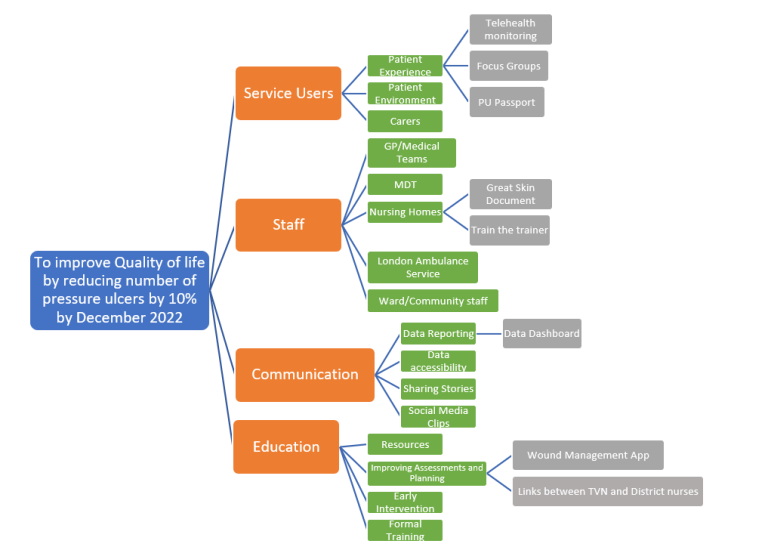
Perspectives from Newham Inpatient Unit…
11th August 2017

The power of safety huddles; identification, prediction & strengthening team work.
By Emma Binley, QI Lead for Newham & Improvement Advisor to the Newham Violence Reduction Collaborative
& Paul McLaughlin, Borough Lead Nurse & Lead of the Newham Violence Reduction Collaborative
The safety huddle is one component of the safety bundle that has been tested on the inpatient wards across Newham. All of the wards in Newham are now using safety huddles and are trying to huddle at least three times a day.
Where do safety huddles come from?
Safety Huddles are used in other areas of healthcare to encourage effective communication and teamwork and, funnily enough, the idea of huddling originally stems from completely different contexts like American Football and the US Army. Any time you have a group of people trying to achieve a shared aim, you need to have an effective means by which they are encouraged and supported to work together – specifically to take a pause, reflect on what is going on and then to develop strategy and ensure everyone is clear on their roles. This is what happens in American Football – and now this is happening on almost all of our inpatient wards, where we are working together to deliver the best possible care and striving to keep our patients and staff safe and free from harm.
How we structure safety huddles in adult mental health settings?
We believe we’re one of the first organisations around the world to use safety huddles in adult mental health settings. The safety huddle, developed at ELFT, is really focused on providing staff with a structure to help identify and predict when there are risks that are likely to result in violence and aggression and then to take action on these as a team. To do this, we focus on two key questions; staff in the huddle ask “Are you safe?” and “Will anyone be dissatisfied with their care today?”
The first question is prompting staff to reflect on whether there are any pressing risks on the ward, both in terms of individual patient’s behaviour which is likely to result in violence, and ward issues, such as staffing levels or ward occupancy. The second question is drawing on ideas around the importance of human needs and how when needs are unmet, this can lead to agitation, aggression and ultimately violence. If we can better connect with these needs, do what we can to meet them, and show empathy and understanding if we can’t, our work has shown we can prevent incidents. So, the first step is to identify when a need is not being met; reflecting whether anyone one the ward is unhappy really helps us to do that.
Experiences using safety huddles in the Newham Violence Reduction Collaborative
At one of the collaborative learning sets in Newham, staff from Sapphire ward spoke about how the huddles had improved team working on the ward, as it enables them to create and agree on a plan to ensure the safety of others. They also expressed how the huddles create an opportunity to learn new things about the service users on the ward; for example if a staff member knows that a particular service user enjoys something or finds something helpful in a time of distress they are able to share this more effectively with the team.
The safety huddles promote collective leadership and also ensure that risks and concerns are not individually managed but are shared and owned by the entire team. Staff in Newham have spoken about how they feel that the safety huddles are most effective when they are multidisciplinary, as this improves the efficiency of decision making. Ruby Triage spoke positively about how consultants help to initiate the huddle each day at a set time which works really well.
Not only have the huddles strengthened team work they have also provided an opportunity to create dispersed leadership. The safety bundle has empowered some of the more junior staff in Newham to lead on the violence reduction work and they have played a vital role in supporting the ward teams to become more reliable with using the change ideas. One of key learning points identified from the teams is that the improvements and reliability cannot be sustained when it relies on one individual; it needs to be a team effort.
In addition to the fantastic reductions in physical violence on many of the wards in Newham, the safety bundle, collaborative learning sets and empowering leadership has transformed the culture on the inpatient wards, with safety and teamwork being at the heart of this.
At the last collaborative learning set, Opal ward reflected on what works well on days when they do not have incidents of physical or non-physical violence and the group asked if they did anything different on these days. The staff shared that there is the feeling on these days that everyone is on the ward and together working towards making everyone else’s day better.

Learning together at the Newham Violence Reduction Collaborative

Most Read Stories
-
Why is Quality Control important?
18th July 2018

-
2016 QI Conference Poster Presentations
22nd March 2016
-
Recognising Racism: Using QI to Help Take Action
21st January 2021

-
QI Essentials: What does a Chief Quality Officer do?
18th March 2019

-
Using data enabled us to understand our problem
31st March 2023

-
The Power of Data in Reducing Pressure Ulcers
12th January 2022


Follow QI on social media
To keep up to date on the latest concerning QI at ELFT, follow us on our socials.


